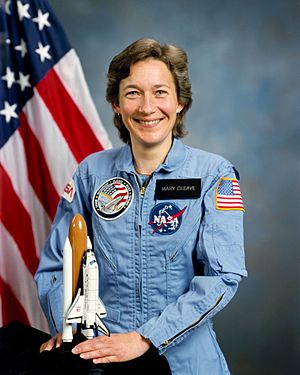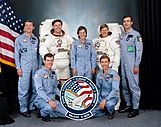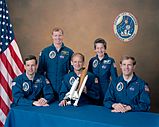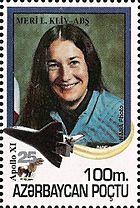Mary L. Cleave facts for kids
Quick facts for kids
Mary Louise Cleave
|
|
|---|---|
 |
|
| Born | February 5, 1947 Southampton, New York, U.S.
|
| Died | November 27, 2023 (aged 76) Annapolis, Maryland, U.S.
|
| Alma mater | |
| Occupation | Environmental Engineer Astronaut |
| Space career | |
| NASA Astronaut | |
|
Time in space
|
10d 22h 02m |
| Selection | 1980 NASA Group |
| Missions | STS-61-B, STS-30 |
|
Mission insignia
|
 |
| Retirement | 2007 |
Mary Louise Cleave (February 5, 1947 – November 27, 2023) was an American engineer and NASA astronaut. She also served from 2005 to 2007 as NASA Associate Administrator for the Science Mission Directorate.
Contents
Early life
Cleave was born in Southampton, New York, as the daughter of Howard Cleave and Barbara Cleave, both teachers. She grew up in Great Neck, New York, and had an older sister, Trudy Carter, and a younger one, Barbara "Bobbie" Cleave Bosworth.
Education
In 1965 Cleave graduated from Great Neck North High School in Great Neck, New York. In 1969 she received a bachelor of science degree in Biological Sciences from Colorado State University, and in 1975 a master of science in Microbial Ecology from Utah State University. In 1979 she received a doctorate in Civil and Environmental Engineering from Utah State University.
Academic career
Cleave held graduate research, research phycologist, and research engineer assignments in the Ecology Center and the Utah Water Research Laboratory at Utah State University from September 1971 to June 1980.
Her work included research on the productivity of the algal component of cold desert soil crusts in the Great Basin Desert south of Snowville, Utah; algal removal with intermittent sand filtration and prediction of minimum river flow necessary to maintain certain game fish and the effects of increased salinity and oil shale leachates on freshwater phytoplankton productivity. She worked on the development of the Surface Impoundment Assessment document and computer program (FORTRAN) for current and future processing of data from surface impoundments in Utah, and the design and implementation of an algal bioassay center and a workshop for bioassay techniques for the Intermountain West.
NASA career
Cleave was selected as an astronaut in May 1980. Her technical assignments have included: flight software verification in the Shuttle Avionics Integration Laboratory (SAIL); CAPCOM on five Space Shuttle flights; Malfunctions Procedures Book; Crew Equipment Design. A veteran of two space flights, Cleave logged a total of 10 days, 22 hours, 02 minutes, 24 seconds in space, orbited the Earth 172 times and travelled 3.94 million miles. She was a mission specialist on STS-61-B (November 26 to December 3, 1985) and STS-30 (May 4–8, 1989).
Cleave left JSC in May 1991 to join NASA's Goddard Space Flight Center in Greenbelt, Maryland. She worked in the Laboratory for Hydrospheric Processes as the Project Manager for SeaWiFS (Sea-viewing, Wide-Field-of-view-Sensor), an ocean colour sensor which is monitoring vegetation globally. Cleave served as Associate Administrator, Science Mission Directorate, NASA Headquarters, Washington, D.C. She stepped down from that position in April 2007 and was succeeded by Dr. Alan Stern.
Spaceflight experience
STS-61-B Atlantis (November 26 to December 3, 1985) launched at night from the Kennedy Space Center, Florida, and returned to land on Runway 22 at Edwards Air Force Base, California. During the mission, the crew deployed the MORELOS-B, AUSSAT II and SATCOM K-2 communications satellites, conducted 2 six-hour spacewalks to demonstrate space station construction techniques with the EASE/ACCESS experiments, operated the Continuous Flow Electrophoresis (CFES) experiment for McDonnell Douglas and a Getaway Special (GAS) container for Telesat, Canada, conducted several Mexican Payload Specialist Experiments for the Mexican Government, and tested the Orbiter Experiments Digital Autopilot (OEX DAP). This was the heaviest payload weight carried to orbit by the Space Shuttle to date. The mission duration was 165 hours, 4 minutes, 49 seconds.
STS-30 on Space Shuttle Atlantis (May 4–8, 1989) was a four-day mission during which the crew successfully deployed the Magellan Venus-exploration spacecraft, the first U.S. planetary science mission launched since 1978, and the first planetary probe to be deployed from the Shuttle. Magellan arrived at Venus in August 1990 and radar-mapped over 95% of the surface of Venus. Magellan has been one of NASA's most successful scientific missions providing valuable information about the Venusian atmosphere and magnetic field. In addition, the crew also worked on secondary payloads involving Indium crystal growth, electrical storm, and Earth observation studies. The mission duration was 96 hours, 57 minutes, 35 seconds.
Death
Cleave died on November 27, 2023, at the age of 76.
Honors and commemoration
In 1995 Cleave featured on a postal stamp in a series issued in Azerbaijan to commemorate the 25th anniversary of the first manned moon landing.
On January 18, 2009, as the inaugural speaker in the Heyden Distinguished Lecture Series, Cleave told students and others at Georgetown University about her education and career and showed an original film of her shuttle mission in 1985.
Organizations
- Society for Professional Engineers
- Association of Space Explorers
- Women in Aerospace
- Tri Beta, Beta Beta Beta
- Sigma Xi
- Tau Beta Pi
See also
 In Spanish: Mary L. Cleave para niños
In Spanish: Mary L. Cleave para niños





